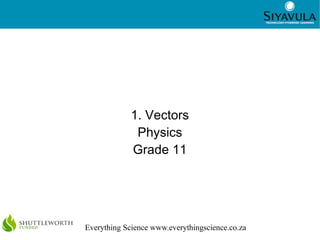Report
Share

Recommended
More Related Content
What's hot
What's hot (20)
Lecture 1 Position, Distance, Displacement; Average Speed And Velocity;...

Lecture 1 Position, Distance, Displacement; Average Speed And Velocity;...
Physical Quantities--Units and Measurement--Conversion of Units

Physical Quantities--Units and Measurement--Conversion of Units
Similar to Vectors in two dimensions
Similar to Vectors in two dimensions (20)
More from Siyavula
More from Siyavula (20)
Volunteer translation of open textbooks in South Africa

Volunteer translation of open textbooks in South Africa
Recently uploaded
Mehran University Newsletter is a Quarterly Publication from Public Relations OfficeMehran University Newsletter Vol-X, Issue-I, 2024

Mehran University Newsletter Vol-X, Issue-I, 2024Mehran University of Engineering & Technology, Jamshoro
Recently uploaded (20)
Interdisciplinary_Insights_Data_Collection_Methods.pptx

Interdisciplinary_Insights_Data_Collection_Methods.pptx
On National Teacher Day, meet the 2024-25 Kenan Fellows

On National Teacher Day, meet the 2024-25 Kenan Fellows
Unit 3 Emotional Intelligence and Spiritual Intelligence.pdf

Unit 3 Emotional Intelligence and Spiritual Intelligence.pdf
This PowerPoint helps students to consider the concept of infinity.

This PowerPoint helps students to consider the concept of infinity.
HMCS Vancouver Pre-Deployment Brief - May 2024 (Web Version).pptx

HMCS Vancouver Pre-Deployment Brief - May 2024 (Web Version).pptx
Micro-Scholarship, What it is, How can it help me.pdf

Micro-Scholarship, What it is, How can it help me.pdf
HMCS Max Bernays Pre-Deployment Brief (May 2024).pptx

HMCS Max Bernays Pre-Deployment Brief (May 2024).pptx
Food safety_Challenges food safety laboratories_.pdf

Food safety_Challenges food safety laboratories_.pdf
Basic Civil Engineering first year Notes- Chapter 4 Building.pptx

Basic Civil Engineering first year Notes- Chapter 4 Building.pptx
Vectors in two dimensions
- 1. 1 1. Vectors Physics Grade 11 Everything Science www.everythingscience.co.za
- 2. 2 Vectors - revision A vector is a physical quantity with magnitude and direction. Vectors can be used to represent many physical quantities that have a magnitude and direction, like forces. Vectors may be represented as arrows where the length of the arrow indicates the magnitude and the arrowhead indicates the direction of the vector. Everything Science www.everythingscience.co.za
- 3. 3 Vectors on the Cartesian plane We can represent vectors on the Cartesian plane. The vectors can be placed anywhere on the Cartesian plane as long as the magnitude and direction of the vector is correctly indicated. Everything Science www.everythingscience.co.za
- 4. 4 Vectors on the Cartesian plane continued Vectors can also be drawn at an angle to one of the axes. When we do this we specify the angle as acting anti-clockwise from the positive x-axis. Everything Science www.everythingscience.co.za
- 5. 5 The resultant vector The resultant of a number of vectors is the single vector whose effect is the same as the individual vectors acting together. Everything Science www.everythingscience.co.za
- 6. 6 Sketching the resultant We can sketch vectors in two dimensions using the tail-to-head method. In this method the tail of one vector is placed at the head of the other vector. Everything Science www.everythingscience.co.za
- 7. 7 Sketching the resultant continued We can also first find the resultant in the x-direction and then find the resultant in the y-direction before finding the final resultant. Everything Science www.everythingscience.co.za
- 8. 8 Tail-to-tail method of sketching the resultant We can use the tail-to-tail method to sketch the resultant. This is illustrated below. Everything Science www.everythingscience.co.za
- 9. 9 Closed vector diagrams A closed vector diagram is a set of vectors drawn on the Cartesian using the tail-to-head method and that has a resultant with a magnitude of zero. This means that if the first vector starts at the origin the last vector drawn must end at the origin. The vectors form a closed polygon, no matter how many of them are drawn. Here are a few examples of closed vector diagrams: Everything Science www.everythingscience.co.za
- 10. 10 Finding the resultant Using the algebraic techniques of vector addition from grade 10 and Pythagoras' theorem we can find the magnitude of the resultant of vectors in two dimensions. We first find the resultant in the x-direction and then find the resultant in the y-direction. Finally we note that when we draw these two vectors head-to-tail we get a right angled triangle that has the resultant of the vectors as the hypotenuse. The magnitude of the resultant can be calculated algebraically or measured graphically from a scale diagram. The direction can be measured from a scale diagram or calculated using trigonometry. Everything Science www.everythingscience.co.za
- 11. 11 Components of vectors We can resolve any vector into components. This can be done algebraically or graphically. We can use: and R x =R cos R y =R sin to calculate the magnitude of the x- and y-components. Everything Science www.everythingscience.co.za
- 12. 12 Components of vectors continued We can extend this to vectors in two dimensions. Everything Science www.everythingscience.co.za
- 13. 13 For more practice see: everythingscience.co.za Shortcode: ESBKF Everything Science www.everythingscience.co.za
